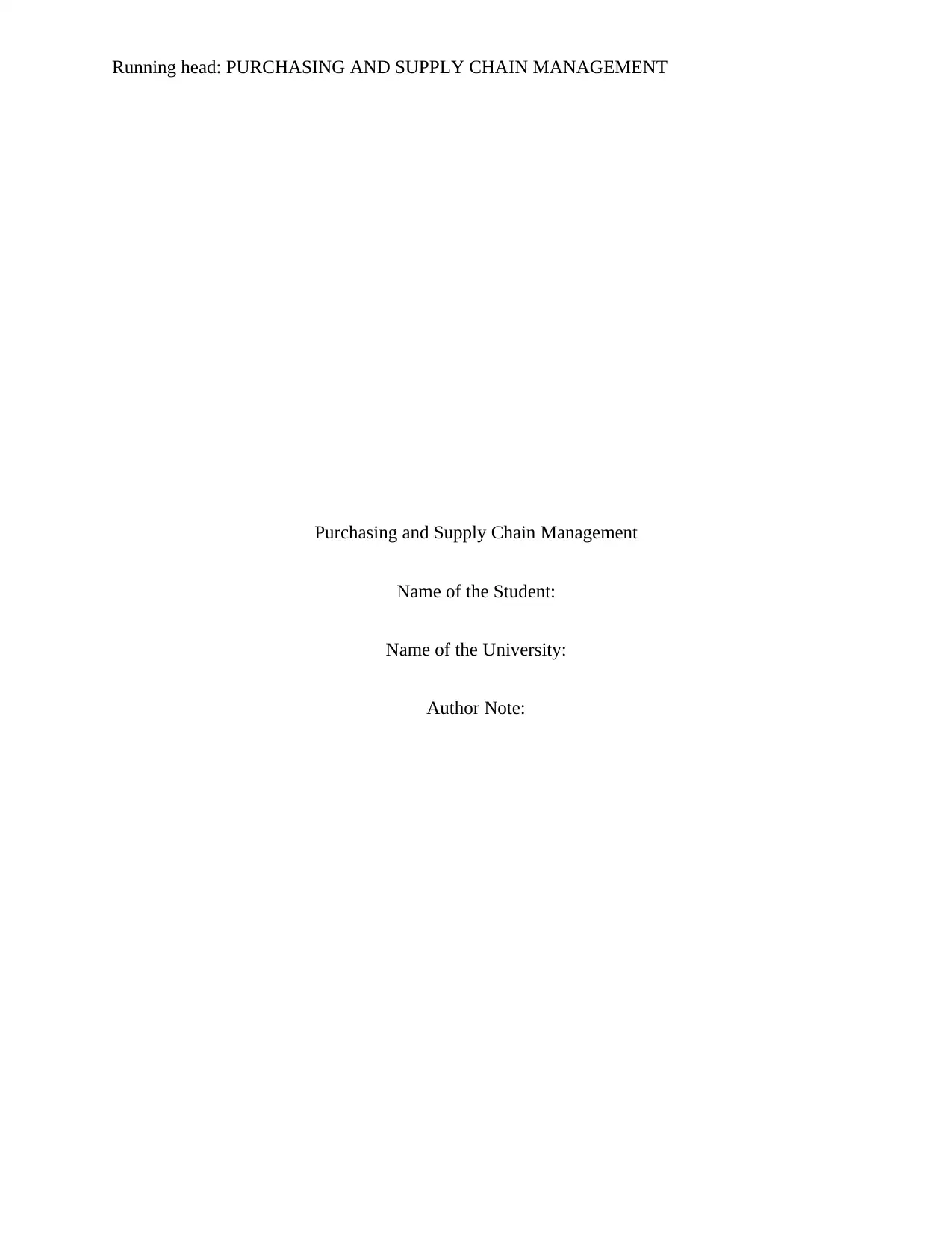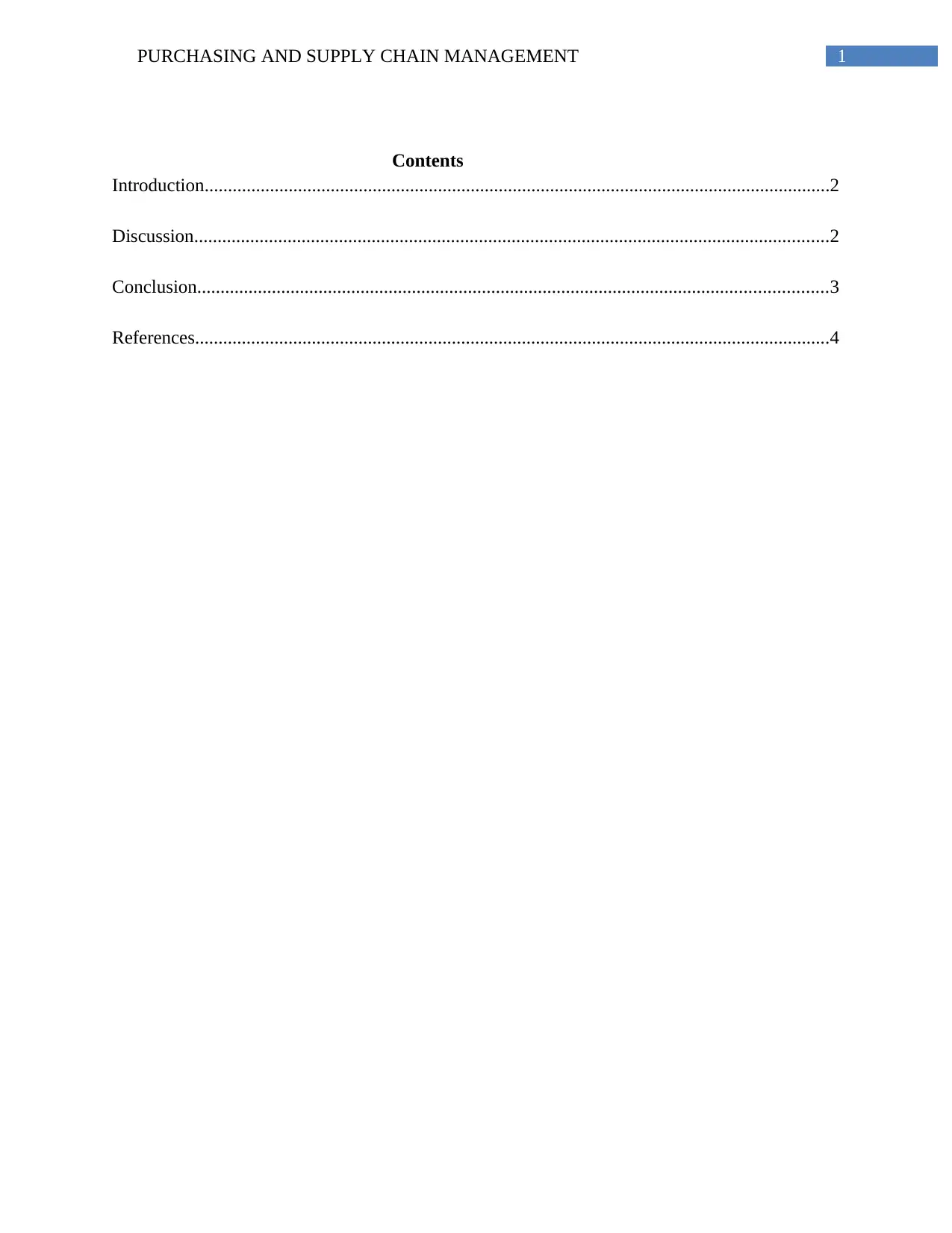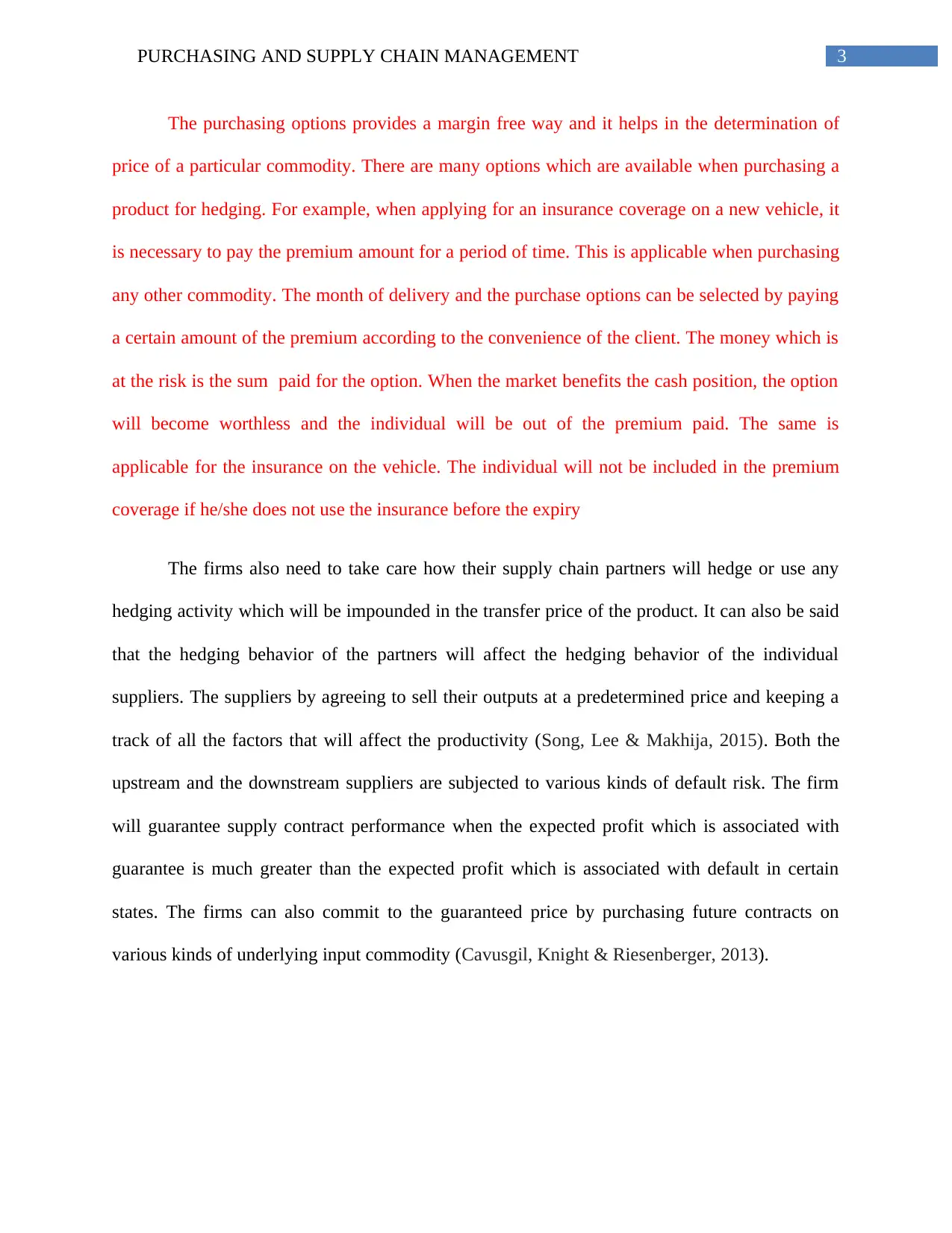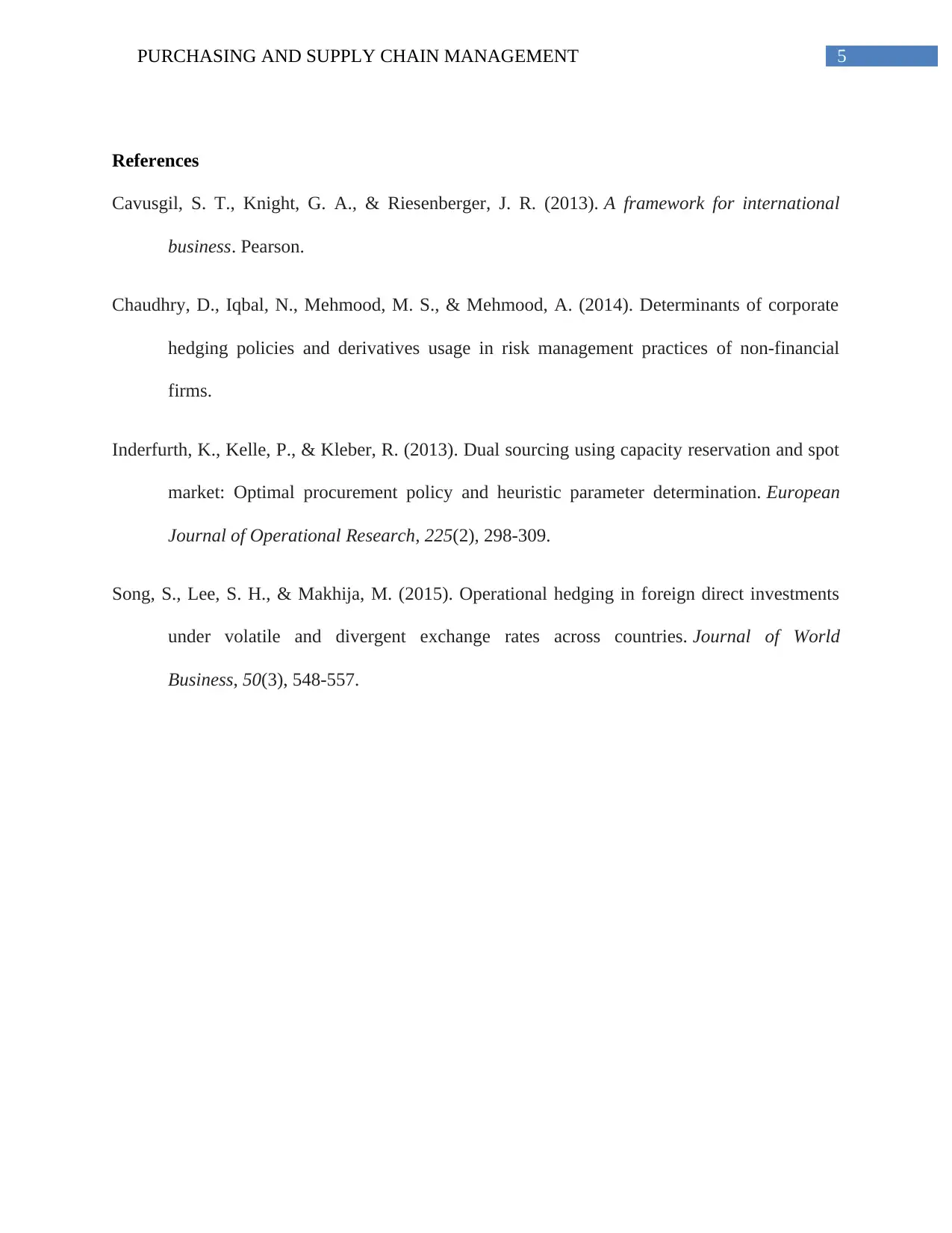Strategic Purchasing Policies and Hedging in Supply Chain Management
VerifiedAdded on 2020/04/21
|6
|954
|87
Report
AI Summary
This report examines hedging strategies within the context of purchasing and supply chain management, focusing on how firms manage price risks and supply disruptions. It explores the use of hedging options, such as purchasing commodities and financial instruments to mitigate financial losses. The report highlights the impact of price increases on suppliers, referencing examples like the steel industry, and discusses how purchasing policies can influence hedging behaviors. It emphasizes the importance of considering the hedging activities of supply chain partners and the role of guaranteed supply contracts. The conclusion underscores the need for equilibrium hedging policies to maintain supply chain stability and the benefits of financial hedging in managing stochastic demand.

Running head: PURCHASING AND SUPPLY CHAIN MANAGEMENT
Purchasing and Supply Chain Management
Name of the Student:
Name of the University:
Author Note:
Purchasing and Supply Chain Management
Name of the Student:
Name of the University:
Author Note:
Paraphrase This Document
Need a fresh take? Get an instant paraphrase of this document with our AI Paraphraser

1PURCHASING AND SUPPLY CHAIN MANAGEMENT
Contents
Introduction......................................................................................................................................2
Discussion........................................................................................................................................2
Conclusion.......................................................................................................................................3
References........................................................................................................................................4
Contents
Introduction......................................................................................................................................2
Discussion........................................................................................................................................2
Conclusion.......................................................................................................................................3
References........................................................................................................................................4

2PURCHASING AND SUPPLY CHAIN MANAGEMENT
Introduction
Hedging strategies are the options which are exercised in relation to the price, demand
and exchange rate contingencies that are faced by the firm in the supply chain context. These are
regarded as the supply chain networks which are derived through global co-ordination of the
production and sourcing decisions. This paper will explain hedging in relationship to strategic
purchasing policies in a manufacturing context. In a supply chain environment, the firms will
find themselves exposed to the price risks and the supply chain which is related to the price risk
of the partner. Moreover, the supply chain firms cannot control the price risk through the process
of hedging alone (Inderfurth, Kelle & Kleber,2013).
Discussion
In a supply chain, increase in price can result in the financial loss of the suppliers. The
situation will become worsen to such a point in the supply disruption that the suppliers cannot
make the products profitably. For example, in 2011, steelmakers have tried to increase the price
by six times and this led to a total increase in the revenue by 30%. On the other hand, according
to the extant theory there are many car and appliance manufacturers who did not pay much
attention to the increase in the steel price. This is because they do not purchase the steel from the
steelmakers directly. However, this has become a massive problem for the financial weaker
suppliers for whom the cost of the steel was a greater concern. This situation will become worsen
to the point of supply disruption because the suppliers cannot profitably manufacture products
for their buyers (Chaudhry et al., 2014).
Introduction
Hedging strategies are the options which are exercised in relation to the price, demand
and exchange rate contingencies that are faced by the firm in the supply chain context. These are
regarded as the supply chain networks which are derived through global co-ordination of the
production and sourcing decisions. This paper will explain hedging in relationship to strategic
purchasing policies in a manufacturing context. In a supply chain environment, the firms will
find themselves exposed to the price risks and the supply chain which is related to the price risk
of the partner. Moreover, the supply chain firms cannot control the price risk through the process
of hedging alone (Inderfurth, Kelle & Kleber,2013).
Discussion
In a supply chain, increase in price can result in the financial loss of the suppliers. The
situation will become worsen to such a point in the supply disruption that the suppliers cannot
make the products profitably. For example, in 2011, steelmakers have tried to increase the price
by six times and this led to a total increase in the revenue by 30%. On the other hand, according
to the extant theory there are many car and appliance manufacturers who did not pay much
attention to the increase in the steel price. This is because they do not purchase the steel from the
steelmakers directly. However, this has become a massive problem for the financial weaker
suppliers for whom the cost of the steel was a greater concern. This situation will become worsen
to the point of supply disruption because the suppliers cannot profitably manufacture products
for their buyers (Chaudhry et al., 2014).
⊘ This is a preview!⊘
Do you want full access?
Subscribe today to unlock all pages.

Trusted by 1+ million students worldwide

3PURCHASING AND SUPPLY CHAIN MANAGEMENT
The purchasing options provides a margin free way and it helps in the determination of
price of a particular commodity. There are many options which are available when purchasing a
product for hedging. For example, when applying for an insurance coverage on a new vehicle, it
is necessary to pay the premium amount for a period of time. This is applicable when purchasing
any other commodity. The month of delivery and the purchase options can be selected by paying
a certain amount of the premium according to the convenience of the client. The money which is
at the risk is the sum paid for the option. When the market benefits the cash position, the option
will become worthless and the individual will be out of the premium paid. The same is
applicable for the insurance on the vehicle. The individual will not be included in the premium
coverage if he/she does not use the insurance before the expiry
The firms also need to take care how their supply chain partners will hedge or use any
hedging activity which will be impounded in the transfer price of the product. It can also be said
that the hedging behavior of the partners will affect the hedging behavior of the individual
suppliers. The suppliers by agreeing to sell their outputs at a predetermined price and keeping a
track of all the factors that will affect the productivity (Song, Lee & Makhija, 2015). Both the
upstream and the downstream suppliers are subjected to various kinds of default risk. The firm
will guarantee supply contract performance when the expected profit which is associated with
guarantee is much greater than the expected profit which is associated with default in certain
states. The firms can also commit to the guaranteed price by purchasing future contracts on
various kinds of underlying input commodity (Cavusgil, Knight & Riesenberger, 2013).
The purchasing options provides a margin free way and it helps in the determination of
price of a particular commodity. There are many options which are available when purchasing a
product for hedging. For example, when applying for an insurance coverage on a new vehicle, it
is necessary to pay the premium amount for a period of time. This is applicable when purchasing
any other commodity. The month of delivery and the purchase options can be selected by paying
a certain amount of the premium according to the convenience of the client. The money which is
at the risk is the sum paid for the option. When the market benefits the cash position, the option
will become worthless and the individual will be out of the premium paid. The same is
applicable for the insurance on the vehicle. The individual will not be included in the premium
coverage if he/she does not use the insurance before the expiry
The firms also need to take care how their supply chain partners will hedge or use any
hedging activity which will be impounded in the transfer price of the product. It can also be said
that the hedging behavior of the partners will affect the hedging behavior of the individual
suppliers. The suppliers by agreeing to sell their outputs at a predetermined price and keeping a
track of all the factors that will affect the productivity (Song, Lee & Makhija, 2015). Both the
upstream and the downstream suppliers are subjected to various kinds of default risk. The firm
will guarantee supply contract performance when the expected profit which is associated with
guarantee is much greater than the expected profit which is associated with default in certain
states. The firms can also commit to the guaranteed price by purchasing future contracts on
various kinds of underlying input commodity (Cavusgil, Knight & Riesenberger, 2013).
Paraphrase This Document
Need a fresh take? Get an instant paraphrase of this document with our AI Paraphraser

4PURCHASING AND SUPPLY CHAIN MANAGEMENT
Conclusion
Thus, it can be said that to sustain hedging in the equilibrium position, it is important for
both the firms to hedge and maintain the supply chain breakdown. This equilibrium hedging
policy is considered as partial hedging policy. In certain situations, it is seen that the firms hedge
in equilibrium although it reduces the expected payoff. The financial hedging of stochastic
demand will also help in increasing the supply chain. Thus, it can be said that hedging policies
tries to eliminate the price risk which is associated with it. The firm will try not to get engaged in
hedging when they glitches in supply because such activities expose the firms to financial losses.
Conclusion
Thus, it can be said that to sustain hedging in the equilibrium position, it is important for
both the firms to hedge and maintain the supply chain breakdown. This equilibrium hedging
policy is considered as partial hedging policy. In certain situations, it is seen that the firms hedge
in equilibrium although it reduces the expected payoff. The financial hedging of stochastic
demand will also help in increasing the supply chain. Thus, it can be said that hedging policies
tries to eliminate the price risk which is associated with it. The firm will try not to get engaged in
hedging when they glitches in supply because such activities expose the firms to financial losses.

5PURCHASING AND SUPPLY CHAIN MANAGEMENT
References
Cavusgil, S. T., Knight, G. A., & Riesenberger, J. R. (2013). A framework for international
business. Pearson.
Chaudhry, D., Iqbal, N., Mehmood, M. S., & Mehmood, A. (2014). Determinants of corporate
hedging policies and derivatives usage in risk management practices of non-financial
firms.
Inderfurth, K., Kelle, P., & Kleber, R. (2013). Dual sourcing using capacity reservation and spot
market: Optimal procurement policy and heuristic parameter determination. European
Journal of Operational Research, 225(2), 298-309.
Song, S., Lee, S. H., & Makhija, M. (2015). Operational hedging in foreign direct investments
under volatile and divergent exchange rates across countries. Journal of World
Business, 50(3), 548-557.
References
Cavusgil, S. T., Knight, G. A., & Riesenberger, J. R. (2013). A framework for international
business. Pearson.
Chaudhry, D., Iqbal, N., Mehmood, M. S., & Mehmood, A. (2014). Determinants of corporate
hedging policies and derivatives usage in risk management practices of non-financial
firms.
Inderfurth, K., Kelle, P., & Kleber, R. (2013). Dual sourcing using capacity reservation and spot
market: Optimal procurement policy and heuristic parameter determination. European
Journal of Operational Research, 225(2), 298-309.
Song, S., Lee, S. H., & Makhija, M. (2015). Operational hedging in foreign direct investments
under volatile and divergent exchange rates across countries. Journal of World
Business, 50(3), 548-557.
⊘ This is a preview!⊘
Do you want full access?
Subscribe today to unlock all pages.

Trusted by 1+ million students worldwide
1 out of 6
Related Documents
Your All-in-One AI-Powered Toolkit for Academic Success.
+13062052269
info@desklib.com
Available 24*7 on WhatsApp / Email
![[object Object]](/_next/static/media/star-bottom.7253800d.svg)
Unlock your academic potential
Copyright © 2020–2025 A2Z Services. All Rights Reserved. Developed and managed by ZUCOL.


